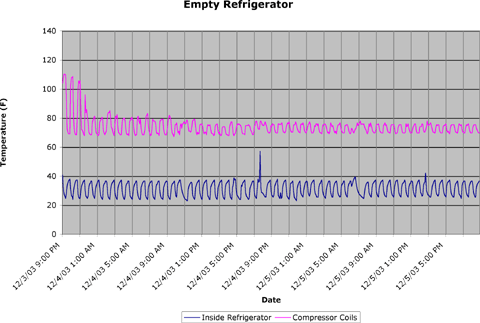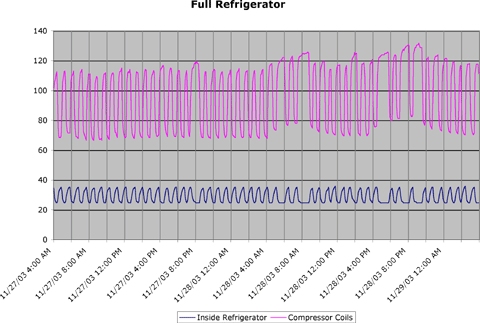
With EMPTY refrigerator

The compressor coils ran at an average temperature of 74*F, and the average inside temperature was 31*F. There are two spikes in the data that indicate an opening of the refrigerator door. The compressor ran for an average of 26 minutes per cycle.
With FULL refrigerator

The compressor coils ran at an average temperature of 97*F, and the average inside refrigerator temperature was 29*F. During this experiment there were two door openings, although they do not show up as temperature fluctuations in the graph The compressor ran for an average of 32 minutes per cycle.
Temperature Fluctuation
The graphs show a smoother temperature fluctuation curve in the full refrigerator, which is regulated by the heat storage capacity of the water. Conversely, the heat capacity of air is far lower, explaining the sharper fluctuations in the empty refrigerator.
When the full refrigerator was opened, the events are not evident on the temperature graph. However, when the empty refrigerator was opened, the events appear as temperature spikes. We attribute this increase in temperature stability to the reduction of air infiltration created by the volume of the water jugs.
Coolant Temperature & Compressor Activity
The graphs indicate that the refrigerator compressor cycles at a relatively constant rate. It should also be noted, the compressor cycled approximately 20% longer when the refrigerator was full than when it was empty.
The graphs also show more heat must be removed form the full refrigerator than the empty one in order to keep all of its contents at the proper temperature. The increase in heat removal is manifested in higher coolant temperature, which never gets a chance to cool in the reservoir. Furthermore, since the temperature inside the refrigerator remains the same when full or empty, it shows the coolant is just as effective at this higher temperature. However, we cannot conclude greater efficiency since we have no knowledge of increased electricity use.
We assumed the water, acting as a heat sink, would stabilize the temperature in the refrigerator. We thought this would translate into less work for the compressor. The shorter cycles and higher coil temperature of the full refrigerator show, however, that more heat is being removed from the refrigerator compartment in order to maintain interior temperature, rendering it less efficient.